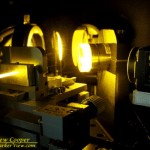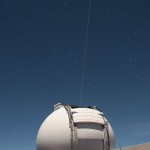We were doing more engineering tests with the K1 laser Sunday night. And as usual, Dan Birchall, working the night over at Subaru, took advantage of the opportunity to do some time lapse photography. Enjoy…
Tag: laser
Just a Little Nudge
One of the tasks I have helped with on the K1 AO Laser is aligning the Launch Telescope Assembly (LTA). This is not so much an electrical engineer’s task, but a mechanical one. So how did I end up with the task? Simple, I was present the first time it was done. Since the mechanical engineer who was first responsible has now left the observatory, I get the job by default. Just the way things work around here.
The launch telescope is a small telescope, about 0.5 meter in aperture, that projects the laser into the sky. Mounted behind the secondary mirror of the Keck 1 telescope, it must be precisely aimed to exactly the same spot in the sky the main telescope is aimed.
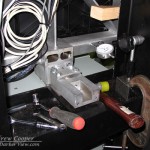
In practice this adjustment is about one to two hours crouched in the secondary assembly of the Keck 1 telescope. Each time the bolts are tightened the assembly moves about 10-15 thousandths of an inch. Thus I have to guess how much to offset the measurement so it ends up correct when the bolts are tight. It takes anywhere from three to five repetitions to get right sometimes.
This is where I curse the mechanical engineer who dreamed up the mounting for the launch telescope. I look at the dial indicators, shift my stance against the cold steel to stop the cramping, loosen the bolts and try again.
The last adjustment was a mere 0.004″ (four one-thousandths of an inch) to move the pointing about 30 arc-seconds on the sky. I am now only about 10 arc-seconds from the optical axis. Keep in mind that a single arc-second is 1/60th of an arc-minute, which is in turn 1/60th of a degree. Ten arc-seconds is pretty good, but we want closer. Here I go one more time…
Oops, a little too much power there…
How powerful is the K1 AO laser?
For someone who has lately been used to working around relatively harmless power levels, beams of a few milliwatts, this is a reminder that lasers are potentially very dangerous. With a milliwatt power level beam there is no danger in getting a hand in the beam, be mindful of your eyes, but otherwise not a lot of concern. This is vastly different, beam power here is measured in tens of watts… The bright yellow beam looks so innocent, appears so harmless. Give that beam a chance, a momentary slip, and it will burn you… badly.
Anything in the beam is at risk, even components we thought were robust enough to withstand the power levels. In this case a reflective ND filter that was to reflect most of the beam into a beam dump, allowing a small amount to continue up the beam train for use in alignments. So much for the ratings on the manufacturer’s data sheet, the beam punched through the coating and even started to melt the glass…
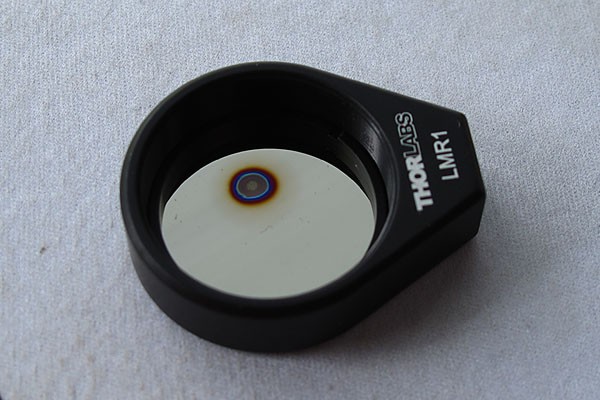
A Beam of Yellow to Pierce the Sky
Yellow light, specifically light at 589nm, the yellow glow of excited neutral sodium. A color of light familiar to anyone who has stood under the soft glow of low pressure sodium streetlights. A laser shining at 589nm, aimed high into the atmosphere, will encounter a layer of sodium atoms at an altitude of 90km (60miles). When the yellow light strikes this sodium it will excite the atoms and cause them to glow, creating a dot of light, an artificial ‘star’ in the sky.
An artificial star, a useful thing if you want to analyze the distortion caused by the atmosphere. If you can understand these distortions you can use the information to correct the images of an instrument looking though the atmosphere, creating sharp views of stars and galaxies, views vastly better than were possible before the advent of adaptive optics. Such system are now routinely used on large telescopes across the globe to allow a clear view of the universe we live in.
Adaptive optics systems are amazingly complex instruments. Hundreds of filters, lenses, mirrors and other optical surfaces interact with dozens of motorized stages and half a dozen cameras. Controlling the system are a horde of computers, some of which are specialized machines with impressive processing power. Everything must work in concert, the failure of one element can bring the whole system down.
A laser is not necessary for an operating AO system, but without it there is 70% of the sky that can not be observed, making a laser highly desirable. While the K2 AO laser has been operating for several years, Keck Observatory has never had a laser on the Keck 1 telescope.
Continue reading “A Beam of Yellow to Pierce the Sky”Green Laser Trouble
Sounds like someone acting very foolishly has pointed a green laser at aircraft around the Hilo airport. Thanks to Baron for noting the HPD press release on the issue. I wonder if there is someone out there who is unaware that aiming a laser at an aircraft is a violation of federal law.
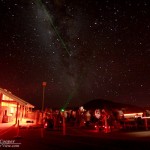
These lasers are also immensely useful. At the VIS and other local star parties we use green lasers to point out the constellations and to educate our visitors about the sky. There is nothing like being able to point out a specific star, nebula or galaxy directly, you can instantly connect an entire audience with the sky without the usual confusion. Friday night it was a green laser that served as a link to the stars when I used it on the patio of the Mauna Kea VIS.
I use a laser under 30mW, bright enough to be seen by a large crowd, as well as being visible with a bright Moon in the sky, but with a low enough power to be reasonably safe. Above about 50mW these laser pointers become much more dangerous as the laser can inflict injury to the eye faster than you can blink and turn away. Fortunately there is almost no air traffic over Mauna Kea making this a place where you can use the lasers with little worry. Another personal rule I follow is to never let kids handle this laser, even though they always clamor to see this bright wonder of technology.
I can only hope this issue does not attract the attention of our reactionary county council, they have a tendency to ban anything that even seems dangerous. This would be another classic case of one stupid person creating problems for those of us who use a technology responsibly.
Laser Launch Telescope
A big milestone arrived this week. The launch telescope arrived from the manufacturer. It is an impressive instrument itself, a half meter aperture, an extraordinarily short focal length, made to very exacting precisions, even for optics. It is a cassegrain design with an focal ratio of f/1. The primary is coated with a custom coating designed for maximum reflectance at the 589nm sodium D line, where the laser will operate. This gives the primary a notably orange cast that is quite beautiful. The entire telescope is enclosed in an airtight aluminum shell with the optics supported on a carbon fiber frame within.
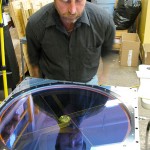
The entire assembly will mount behind the secondary of K1. This is different than the current laser in Keck 2 that is emitted from a launch telescope along the side of the main telescope. Having the laser on the side creates some problems for the AO wavefront controller, the artificial guidestar can be elongated by parallax when seen from the other side of a ten meter telescope. Having the laser launched from the center of the main telescope is a far more optimal solution. But doing that takes a far more difficult to design and build launch telescope as it has to be extraordinarily compact.
We expect delivery of the laser itself in May. Our laser engineer has been working with the laser manufacturer to insure it meets all specifications. Reports indicate it is not only meeting those specifications, but surpassing them. When we take delivery there will be a period of testing before the equipment is trucked to the mountain for installation in its final position.
The coming week will be fun, need to string a new set of cables to the Keck 1 secondary mirror. This means 150 feet of cabling from the Nasmyth Deck, up the tubular structure of the telescope and across the spider to the secondary. On a ten meter telescope this means a lot of high work from the personnel bucket of the jib crane among the girders of the telescope. This is going to be fun!
Public Astronomy Laser Power and Safety
How bright a laser beam is needed to allow good public presentations and a good astronomy education experience? In the United States legal green lasers are limited to 5 milliwatts (mW) by the Food and Drug Administration. Many of the lasers sold as 5mW are actually 3-4mW as it is necessary to stay below that limit if you wish to import the laser into the United States or to sell the laser across state lines. 5mW units are fine if you are under fully dark skies, but often you are not, there are city lights, or moonlight and the 5mW beam ceases to be usably visible. This is worse if you are working with a larger group and the distance from the presenter is larger, also making the beam less visible. In practice I have found a beam in the 20-30mW range is about ideal. These lasers are available from a number of sources for around $100. Good visibility in moonlight, good visibility in light polluted surroundings and good large group utility. But importantly, not powerful enough to be truly dangerous.
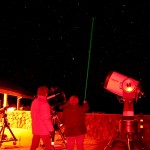
How do I come up with the 20-30mW number as being relatively safe? Being an engineer I understand safety margins and over specification and figured there must be a compromise. The trick was to find undistorted data, without the bias of overcautious bureaucrats. The data is out there on the web, but took some digging to find, many medical journal articles are hidden behind subscription services. Fortunately there are sources like PubMed that are freely and publicly accessible. Eventually I found and read several very informative papers on lasers and eye damage, looked at pictures of laser damage on monkey retinas and looked a damage done by visible lasers in the same sort of power class as those available for public work. I was surprised by actual human damage studies, done on patients who were having eyes removed due to conditions like cancer, where the researcher could do damage without harming the patient. What I was looking for was just what level of laser radiation is dangerous in practical use.

A 20-30mW laser needs to be treated with respect as injury is possible, but no more than any other dangerous tool we use every day. In practice damage with a laser at a sensible power level (20-30mW) would require prolonged exposure (>0.5sec) on a single site on the retina, requiring staring into the beam. The bright green light would elicit both a blink response and an aversion of the head and eye, particularly in a visually dark adapted environment. I would strongly discourage use of any laser 50mW or greater for public astronomy work. Some of the references showed significant damage inflicted with 50mW lasers and sub second exposures. Lasers at all power levels should be kept out of the hands of anyone too young to understand the implications of the danger posed by a laser.
Retinopathy From a Green Laser Pointer, Dennis M. Robertson, MD; Jay W. McLaren, PhD; Diva R. Salomao, MD; Thomas P. Link, CRA, Arch Ophthalmology 2005;123:629-633 [Note: direct testing of a 5mW green laser pointer on a human subject]
Assessment of Alleged Retinal Laser Injuries, Martin A. Mainster, PhD, MD; Bruce E. Stuck, MS; Jeremiah Brown, Jr, MD, MS, Arch Ophthalmol. 2004;122:1210-1217. [Note: good general discussion on the issues of laser injury and great reference list]

